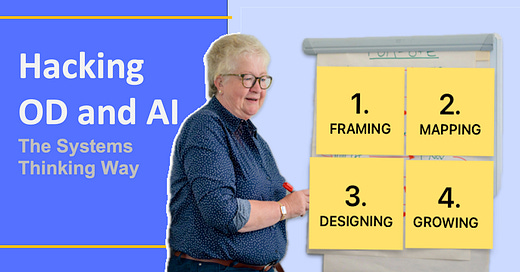AI can Blow Organizations Wide Open
AI slips into the veins of an organization like a silent syringe—no fanfare, just a quiet prick. And it’s in! What follows isn’t just optimization—it’s revelation. Suddenly, the OD practitioner sees the system’s secrets laid bare: twitchy teams, shadow hierarchies, and clotted workflows long past their expiry dates.
This isn’t just tech anymore—it’s a diagnostic superpower. And a chance to rewrite the narrative.
Whether you’re transforming a government agency, rewiring a family business, or scaling AI for social good, you're not following a path—you’re cutting one. This isn’t navigation—it’s co-evolution.
You’re not just observing change—you’re inside it. Wading through a wild, reactive, deeply interconnected landscape. To survive?
Forget checklists. You’ll need a surgeon’s knife for insights—and a compass forged in systems thinking.
Core principles
Systems Thinking moves organizations beyond linear cause-and-effect analysis to embrace the complexity, interdependence, and dynamics of living systems. It enhances decision-making by focusing on relationships, feedback, and emergent behaviors to uncover leverage points for change. Its core principles include:
· Interconnectedness: Every element is linked—changes ripple throughout the system.
· Synthesis: Understanding comes from seeing how parts work together as a whole.
· Emergence: New patterns or behaviors arise from interactions, not visible in isolated parts.
· Feedback Loops: Cycles of influence that can either reinforce growth or balance stability.
· Causality: Cause and effect are often non-linear; identifying leverage points is key.
· Systems Mapping: Visualizing structures and relationships helps diagnose and intervene effectively.
· Boundaries & Reservoirs: Clarifying system limits and tracking stored resources (e.g., carbon, data).
Surviving AI
Framing, Mapping, Designing, and Growing—a four-part guide grounded in systems change science and reimagined for the age of AI, human transformation, and adaptive organizations.
Curious yet? You should be. Because AI is reshaping how change happens while change is happening. So how do you move through the maze with a fresh lens—without getting lost, stuck, or worse, reverting to business-as-usual?
You don’t just charge ahead like you did before—with legacy tools and outdated mindsets.
Systems Thinking and Change
Let’s pause. Take a new lens. Observe. Sense the system’s rhythms. You learn where to cut through—and where to let things grow. In this kind of terrain, conventional tools won’t cut it. You need clarity in the chaos. You need to challenge old assumptions—and a compass of systems mindset to orient every move.
In Practice
This isn’t a checklist—it’s a living approach, rooted in systems change science and supercharged for an era defined by AI, complexity, and human transformation.
Ready to begin?
Let’s start hacking the organization—one system at a time.
FRAME IT LIKE A FUTURIST
Don’t solve problems. Rewire perspectives.
Before you act, stop. Ask: What problem are we really solving?
In complex systems, the “problem” is often a symptom of deeper structures, outdated beliefs, or exclusionary narratives.
OD pros: Surface hidden power dynamics.
AI teams: This is your model-training moment—what you frame is what your code will scale.
Hot Take: Frame challenges with fresh eyes and bold questions. If you haven’t challenged your own assumptions, you’re still in default mode.
MAP WHAT MATTERS
Draw the system. Decode the loops.
It’s not about boxes and arrows—it’s about revealing how change actually happens. Feedback loops. Delays. Leverage points. Conflicts. Tradeoffs. Emotions.
OD facilitators: Map with the people, not for them.
AI developers: Think beyond data flows—what’s invisible but influential?
Pro Tip: Map the real system—feedbacks, friction, and flows. Verify fakes and gossips. The map isn’t the answer. The map is a mirror. Share your maps. Your messes. Your moments of insight.
DESIGN TO DISRUPT
Prototype futures worth living.
Shift from mapping to making. Start small: agile cycles, safe-to-fail experiments, bold iterations. Test the unexpected, measure impact, and course-correct fast.
OD: Bring your best facilitation game. Create “learning zones.”
AI: Design with ethics, not just efficiency.
Design Mantra: Design rapid tests that unlock learning and shift structures. Don’t fix the system. Grow a better one.
GROW WHAT WORKS
(And let go of what doesn’t)
Change only sticks when it’s embedded. That means habits, rituals, governance, and shared meaning. AI needs constant tuning. Humans need ongoing sensemaking.
Your job? Build cultures that learn as they go.
Your edge? Systems that adapt without losing soul.
Real Talk: Grow by embedding change into culture, tech, and everyday choices. Growth isn’t scale. Growth is depth.
So…
We’re not just in the age of change—we’re in the age of complexity.
OD without AI is too slow. AI without OD is too blind.
Let’s stop automating the status quo.
Let’s start co-designing regenerative systems—together.
NOTES
1. Basic ODPN Courses
1.1. In-person from 8am-5pm in the Meralco Power Tech, Ortigas on the dates mentioned: (a) Diagnosing Organizations, Dr Joy Teng-Calleja, PhD, RPsy, June 17 (b) Designing Effective OD Interventions, Dr Melissa Reyes, PhD, August 20 and (c) Process Observation and Analysis, Dr Josephine Perez, PhD, RPsy, September 18.
2. RESERVE A SEAT NOW! The ODPN’s ODLab25: Force for GoOD will be held late July 31 to Aug 1 in Martian Hotel, Zamboanga City. Get the Brochure and Register here or message or call ODPN Secretariate 0925.553.2342.
2. Forthcoming Ed Canela’s AI Seminar Series
2.1. AI for Teachers and Educators on July 31 to August 2, 2025 (3 days from 8:00 to 12:00 NN Zoom), Leadership in the Digital Era, June 20 (8:00 to 12:00 NN Zoom) and Basic OD July 5 (8:00 to 12:00 NN Zoom), SAIDI Graduate School of Organizational Development and Planning. Contact: Ms Cynthia Cruz AT cecruz@SA
2. 2. Aid4Business (for MSMEs) Institute for Small Scale Industries University of the Philippines (UP ISSI) 14 to 16, October 2025. Register here.




